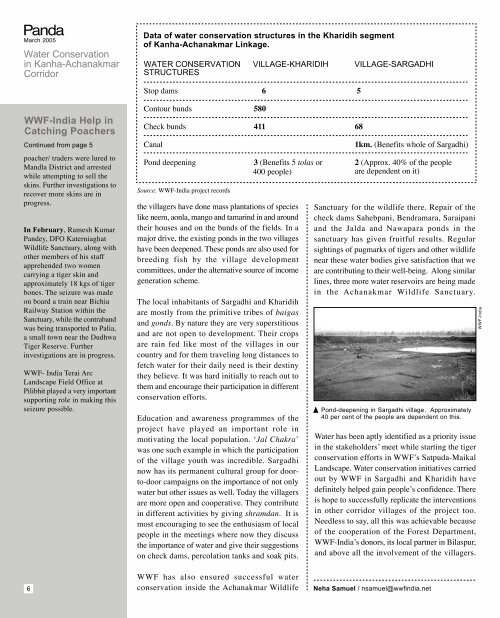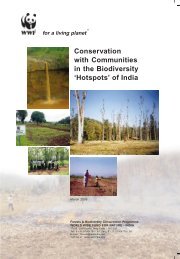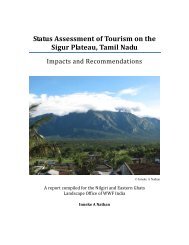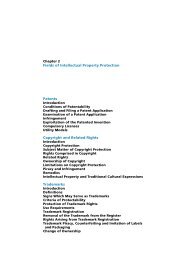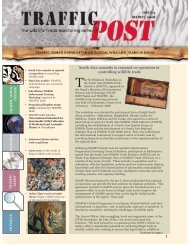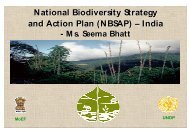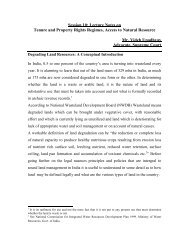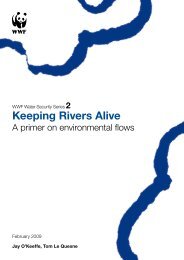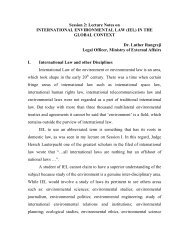The Vanishing Act - WWF-India
The Vanishing Act - WWF-India
The Vanishing Act - WWF-India
You also want an ePaper? Increase the reach of your titles
YUMPU automatically turns print PDFs into web optimized ePapers that Google loves.
Panda<br />
March 2005<br />
Water Conservation<br />
in Kanha-Achanakmar<br />
Corridor<br />
<strong>WWF</strong>-<strong>India</strong> Help in<br />
Catching Poachers<br />
Continued from page 5<br />
poacher/ traders were lured to<br />
Mandla District and arrested<br />
while attempting to sell the<br />
skins. Further investigations to<br />
recover more skins are in<br />
progress.<br />
In February, Ramesh Kumar<br />
Pandey, DFO Katerniaghat<br />
Wildlife Sanctuary, along with<br />
other members of his staff<br />
apprehended two women<br />
carrying a tiger skin and<br />
approximately 18 kgs of tiger<br />
bones. <strong>The</strong> seizure was made<br />
on board a train near Bichia<br />
Railway Station within the<br />
Sanctuary, while the contraband<br />
was being transported to Palia,<br />
a small town near the Dudhwa<br />
Tiger Reserve. Further<br />
investigations are in progress.<br />
<strong>WWF</strong>- <strong>India</strong> Terai Arc<br />
Landscape Field Office at<br />
Pilibhit played a very important<br />
supporting role in making this<br />
seizure possible.<br />
6<br />
Data of water conservation structures in the Kharidih segment<br />
of Kanha-Achanakmar Linkage.<br />
WATER CONSERVATION<br />
STRUCTURES<br />
Stop dams<br />
Contour bunds<br />
Check bunds<br />
Canal<br />
Pond deepening<br />
Source: <strong>WWF</strong>-<strong>India</strong> project records<br />
the villagers have done mass plantations of species<br />
like neem, aonla, mango and tamarind in and around<br />
their houses and on the bunds of the fields. In a<br />
major drive, the existing ponds in the two villages<br />
have been deepened. <strong>The</strong>se ponds are also used for<br />
breeding fish by the village development<br />
committees, under the alternative source of income<br />
generation scheme.<br />
<strong>The</strong> local inhabitants of Sargadhi and Kharidih<br />
are mostly from the primitive tribes of baigas<br />
and gonds. By nature they are very superstitious<br />
and are not open to development. <strong>The</strong>ir crops<br />
are rain fed like most of the villages in our<br />
country and for them traveling long distances to<br />
fetch water for their daily need is their destiny<br />
they believe. It was hard initially to reach out to<br />
them and encourage their participation in different<br />
conservation efforts.<br />
Education and awareness programmes of the<br />
project have played an important role in<br />
motivating the local population. ‘Jal Chakra’<br />
was one such example in which the participation<br />
of the village youth was incredible. Sargadhi<br />
now has its permanent cultural group for doorto-door<br />
campaigns on the importance of not only<br />
water but other issues as well. Today the villagers<br />
are more open and cooperative. <strong>The</strong>y contribute<br />
in different activities by giving shramdan. It is<br />
most encouraging to see the enthusiasm of local<br />
people in the meetings where now they discuss<br />
the importance of water and give their suggestions<br />
on check dams, percolation tanks and soak pits.<br />
<strong>WWF</strong> has also ensured successful water<br />
conservation inside the Achanakmar Wildlife<br />
VILLAGE-KHARIDIH VILLAGE-SARGADHI<br />
6<br />
580<br />
411<br />
3 (Benefits 5 tolas or<br />
400 people)<br />
5<br />
68<br />
1km. (Benefits whole of Sargadhi)<br />
2 (Approx. 40% of the people<br />
are dependent on it)<br />
Sanctuary for the wildlife there. Repair of the<br />
check dams Sahebpani, Bendramara, Saraipani<br />
and the Jalda and Nawapara ponds in the<br />
sanctuary has given fruitful results. Regular<br />
sightings of pugmarks of tigers and other wildlife<br />
near these water bodies give satisfaction that we<br />
are contributing to their well-being. Along similar<br />
lines, three more water reservoirs are being made<br />
in the Achanakmar Wildlife Sanctuary.<br />
Pond-deepening in Sargadhi village. Approximately<br />
40 per cent of the people are dependent on this.<br />
Water has been aptly identified as a priority issue<br />
in the stakeholders’ meet while starting the tiger<br />
conservation efforts in <strong>WWF</strong>’s Satpuda-Maikal<br />
Landscape. Water conservation initiatives carried<br />
out by <strong>WWF</strong> in Sargadhi and Kharidih have<br />
definitely helped gain people’s confidence. <strong>The</strong>re<br />
is hope to successfully replicate the interventions<br />
in other corridor villages of the project too.<br />
Needless to say, all this was achievable because<br />
of the cooperation of the Forest Department,<br />
<strong>WWF</strong>-<strong>India</strong>’s donors, its local partner in Bilaspur,<br />
and above all the involvement of the villagers.<br />
Neha Samuel / nsamuel@wwfindia.net<br />
<strong>WWF</strong>-<strong>India</strong>


